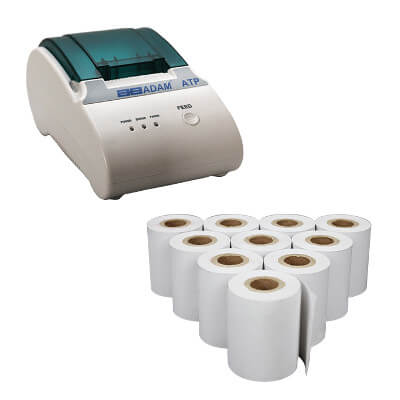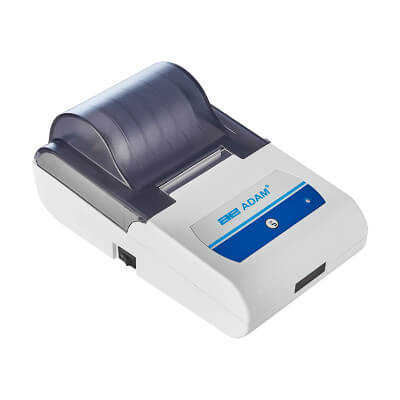
A printer can be very useful when paired with a balance or a scale. They make recording results quick and easy and reduce the risk of transcribing errors. Some printers can be connected directly to the balance or scale to print receipts, measurement logs or inventory counts. Others are connected to a PC which is itself connected to the weighing device. There are multiple types of printers available, and we’ll focus on the two most common: thermal and impact printers.
What is a thermal printer?
As the name indicates, thermal printers use heat to imprint results on special paper, so there’s no need for ink. Some printers heat up to create a reaction between the paper and the pigments, others (usually color printers) use a substance similar to wax that is melted and applied to the paper as it is fed through the printer. If you look at receipts you get from retail stores, a lot of them use thermal printers.
Our own ATP thermal printers print by sending an electrical current to the thermal head, which heats up. Paper is passed through between the thermal head and the roller that feeds paper, and the paper reacts to the heat to generate text and images.
What are some advantages?
Thermal printers are affordable and very easy to use, with a few buttons to accomplish everything. They’re also relatively quiet. Because they don’t have ink, all users need to do is replace the paper. Users can print detailed receipts with bar codes, coupons and ads that can be scanned. They’re quick and reliable, hence their prevalence in POS systems in retail, and in field work for scientific measurements. Our ATP has LED indicators to show if the printer is on, if it needs paper or if there’s an error.
What are some disadvantages?
The quality and sharpness of the text can be uneven or smudged, and it degrades over time. If you’ve ever thrown out old receipts, you might have noticed how faded they could be. That’s not ideal when keeping records.

What is an impact printer?
Impact printers have been around a while. They’re more versatile than you’d think, and are able to print a variety of fonts and even rudimentary graphics.
An impact printer like our AIP works a bit like a typewriter: pins in the printer strike the ink ribbon against paper (hence “impact”) to create impressions. A small electromagnet moves the pins where they need to go. A dot matrix impact printer uses moving pins line by line to print. That gives the printouts the distinct appearance of small dots forming letters and graphics.
What are some advantages?
Impact printers are quite sturdy and can tolerate demanding industrial environments. While the printing quality is not as good as a thermal printer, the printouts last much longer without degradation after time, so they’re well-suited to keep long-term records. They’re also cheap and relatively low maintenance. The AIP has a rechargeable battery for operation even when electricity is not available, and automatically detects the connected device’s settings for efficient communication.
What are some disadvantages?
While the moving pins allow for a decent amount of variety, the quality and resolution are relatively low, so they can’t print bar codes very well, or ads like on receipts. They’re slower and somewhat louder than thermal printers.

Which one should I get?
If you need a quick printer that creates graphics and codes that can be scanned, a thermal printer is the way to go. Thermal printers are well-suited for applications where receipts are necessary. If you need long lasting records and have no need for high resolution graphics, impact printers ensure your records last longer. Still have questions? Don’t hesitate to contact us, we’ll be happy to help you.
Both our printers are compatible with PC software that allows users to perform a variety of commands and set parameters. They can be connected directly to the weighing device or to a computer. They’re compact, efficient and can work with various peripherals.

